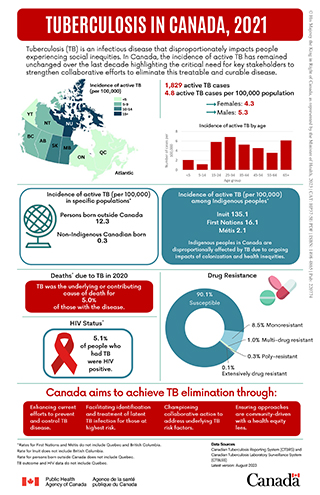Tuberculosis in Canada: Infographic (2021)

Download the alternative format
(PDF format, 419 Kb, 1 page)
- Organization: Public Health Agency of Canada
- Date published: September 2023
Tuberculosis (TB) is an infectious disease that disproportionately impacts people experiencing social inequities. In Canada, the incidence of active TB has remained unchanged over the last decade highlighting the critical need for key stakeholders to strengthen collaborative efforts to eliminate this treatable and curable disease.
In 2021, 1,829 active TB cases were reported in Canada. The corresponding incidence was 4.8 active TB cases per 100,000 population. The incidence for females was 4.3 cases per 100,000, and 5.3 cases per 100,000 for males.
The incidence of active TB by province and territory is presented as a range in four categories (<5, 5-9, 10-14, and 15+ cases per 100,000):
- Yukon: <5
- Northwest Territories: 5-9
- Nunavut: 15+
- British Columbia: 5-9
- Alberta: 5-9
- Saskatchewan: 10-14
- Manitoba: 10-14
- Ontario: <5
- Quebec: <5
- Atlantic provinces: <5
| Age group (years) | Number of cases per 100,000 |
|---|---|
| <5 | 2.1 |
| 5-14 | 1.2 |
| 15-24 | 5.8 |
| 25-34 | 6.8 |
| 35-44 | 5.3 |
| 45-54 | 4.6 |
| 55-64 | 3.6 |
| 65+ | 6.1 |
The incidence of active TB (per 100,000) in specific populationsFootnote *:
- Persons born outside Canada – 12.3
- Non-Indigenous Canadian born - 0.3
The incidence of active TB (per 100,000) among Indigenous peoplesFootnote *:
- Inuit - 135.1
- First Nations – 16.1
- Métis - 2.1
Indigenous peoples in Canada are disproportionally affected by TB due to ongoing impacts of colonization and health inequities.
DeathsFootnote * due to TB in 2020:
- TB was the underlying or contributing cause of death for 5.0% of those with the disease.
HIV StatusFootnote *:
- 5.1% of people who had TB were HIV positive.
Drug Resistance:
- Susceptible to drugs – 90.1%
- Monoresistant - 8.5%
- Multi-drug resistant - 1.0%
- Poly-resistant - 0.3%
- Extensively drug resistant - 0.1%
Canada aims to achieve TB elimination through:
- Enhancing current efforts to prevent and control TB disease.
- Facilitating identification and treatment of latent TB infection for those at highest risk.
- Championing collaborative action to address underlying TB risk factors.
- Ensuring approaches are community-driven with a health equity lens.
Data Sources: Canadian Tuberculosis Reporting System (CTBRS) and Canadian Tuberculosis Laboratory Surveillance System (CTBLSS).
Latest version: September, 2023